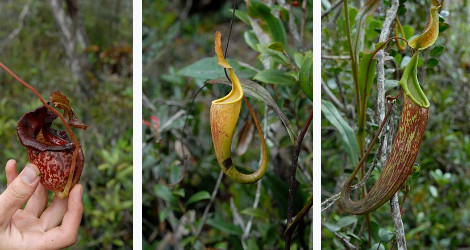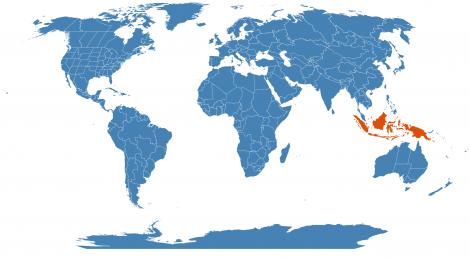Accession Data:
Nepenthes maxima Reinw.
- Common Name: The Great Pitcher Plant
- Family: Nepenthaceae Dumort.
- Synonym(s): Unresolved name - perhaps synonymous with N. celebica or N. curtisii??
- Description: Nepenthes maxima is a highland species occuring principally above 1000 meters (3250ft). This carnivorous plant is grown for the aesthetic value of its urn traps. The urns have a wide peristome and a marbled appearence. The prey can be butterflies, but are usually smaller insects.
- Culture:
- Size - can reach 10 feet
- Light - full sun for outdoor cultivation, filtered light for indoors
- Water - compost and atmosphere must be very moist and humid
- USDA Zone: 11
Accession Data:
- Accession # 198501189
- Source: Unknown
- Accession Date: 12-31-1985
- Bench: 1216 - AUS:Ground Bed 2 SW
- Currently: active - healthy
- Qty: 1 confirmed on 05-16-2025
- Restrictions:
- CITES Appendix II Listed Plant
- CITES Appendix II Listed Plant
Classification:
- Division: Magnoliophyta
- Class: Magnoliopsida
- SubClass: core eudicots
- Order: Caryophyllales
- SubOrder:
- Family: Nepenthaceae
- SubFamily:
- Tribe:
- SubTribe:
Flowering Data:
This accession has been observed in bloom on:| Year | Jan | Feb | Mar | Apr | May | Jun | Jul | Aug | Sep | Oct | Nov | Dec | ||||||||||||||||||||||||||||||||||||||||
|---|---|---|---|---|---|---|---|---|---|---|---|---|---|---|---|---|---|---|---|---|---|---|---|---|---|---|---|---|---|---|---|---|---|---|---|---|---|---|---|---|---|---|---|---|---|---|---|---|---|---|---|---|
| 2025 | ||||||||||||||||||||||||||||||||||||||||||||||||||||
| 2024 | ||||||||||||||||||||||||||||||||||||||||||||||||||||
| 2023 | ||||||||||||||||||||||||||||||||||||||||||||||||||||
| 2022 | ||||||||||||||||||||||||||||||||||||||||||||||||||||
| 2021 | ||||||||||||||||||||||||||||||||||||||||||||||||||||
| 2020 | ||||||||||||||||||||||||||||||||||||||||||||||||||||
| 2019 | ||||||||||||||||||||||||||||||||||||||||||||||||||||
| 2018 | ||||||||||||||||||||||||||||||||||||||||||||||||||||
| 2017 | ||||||||||||||||||||||||||||||||||||||||||||||||||||
| 2016 | ||||||||||||||||||||||||||||||||||||||||||||||||||||
| 2015 | ||||||||||||||||||||||||||||||||||||||||||||||||||||
| 2014 | ||||||||||||||||||||||||||||||||||||||||||||||||||||
| 2013 | ||||||||||||||||||||||||||||||||||||||||||||||||||||
| 2012 | ||||||||||||||||||||||||||||||||||||||||||||||||||||
| 2011 | ||||||||||||||||||||||||||||||||||||||||||||||||||||
| 2010 | ||||||||||||||||||||||||||||||||||||||||||||||||||||
References (internal):
- EEB Greenhouse Holdings native to: Borneo / Jawa / Lesser Sunda Is. / Maluku / Sulawesi / Sumatera / New Guinea
References (external):
- Carnivorous Plants, Marcel Lecoufle, 1993
- Nepenthes maxima at Wikipedia. Accessed 19 May 2015.
- The Plant List (2013). Version 1.1. Last accessed on Monday, February 12, 2018.
- Nepenthes maxima at ARS-GRIN. Last accessed on Monday, February 12, 2018.
- Image #00 (cropped) & #01 (original) taken as screen shot of multiple images by Thomas Gronemeyer [CC BY-SA 4.0 ], via Wikimedia Commons. Last accessed on Monday, July 09, 2018.
data regenerated on Fri, 16 May 2025 10:03:01 -0400 [bcm v4.0]
Images:

Additional images for this accession:
Click on thumbnails to enlargeCurrent Accessions in the Nepenthaceae
- Nepenthes alata

- Nepenthes albomarginata

- Nepenthes copelandii W/C

- Nepenthes maxima


- Nepenthes mirabilis W/C

- Nepenthes sanguinea

- Nepenthes truncata


 = indicates flowering in past 14 days
= indicates flowering in past 14 days
 = images available for this accession
= images available for this accession
 = map available for this accession
= map available for this accession
 = accession added within past 90 days
= accession added within past 90 days

